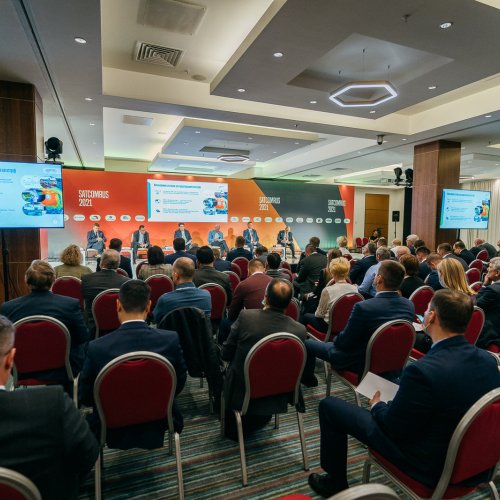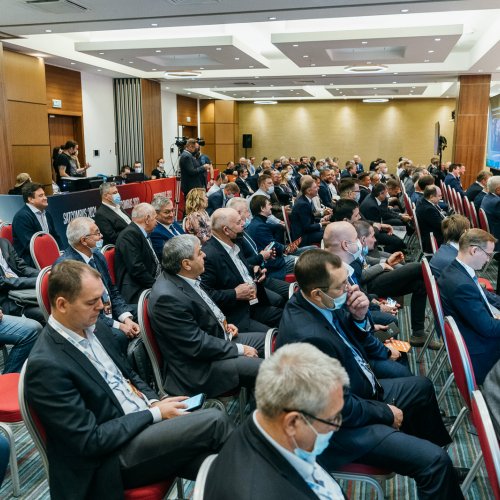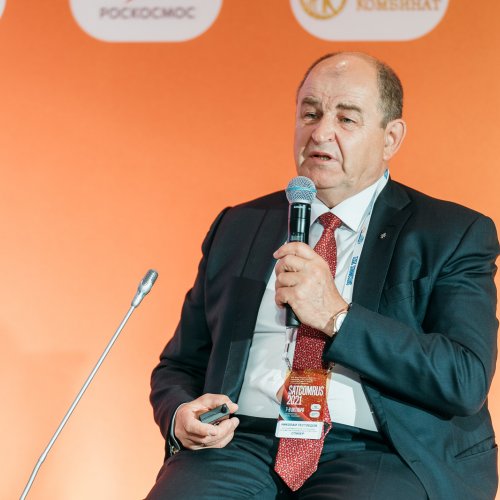Ksenia Drozdova, Director General of Intersputnik, drew the attention of the industry community to environmental and social drivers of further development of the sector. According to the head of Intersputnik, at the present stage of development, humanitarian and environmental aspects are no less important than technical characteristics of spacecraft and networks themselves.
Satellite communications must go green
During the plenary session of the conference, Ksenia Drozdova, Director General of Intersputnik, drew the audience's attention to the humanitarian function of the industry, which, in her opinion, reflected the interconnection of environmental and generational views of the modern society. The humanitarian aspect is one of the fundamental tenets of the new development strategy of Intersputnik for the period up to 2026.
The main argument of the “green” strategy is the fact that it is literally “embedded” in the way of thinking of Gen Z, i.e. people born in 1995-2010. And since right now this generation is entering the economically active age, this factor cannot be ignored, states Ksenia Drozdova.
For Gen Z, when choosing a solution, an extremely important factor is its environmental friendliness and respect for nature at its implementation. Sometimes this factor – e.g., sustainable use of any limited resources – even determines the choice.
Given Gen Z's commitment to electronic devices, involvement in digital culture and, therefore, in broadband networks, it would be unwise for operators to ignore their requests. A telecom operator, in order to make its services understandable and close to this generation, one way or another will have to reconfigure its communication networks with a focus on energy and resource saving technologies.
Cooperation and regulation are key factors
Recently, in connection with the dramatically increased number of spacecraft launched, the question is regularly raised: is it necessary to regulate space traffic and, if yes, in what way? The opinions of satellite market players on this matter differ: someone believes that the players will figure it out themselves, while someone supports state and interstate regulation.
Ksenia Drozdova also focused the audience's attention on the fact that an increasing number of various objects was being put into orbit and there was a serious danger of turning the space into a "littered environment". To avoid this highly unfavorable scenario, global space activities must be regulated and regulatory mechanisms must be fully transparent.
Realizing the importance of coordinating common efforts, Intersputnik cooperates with international structures, primarily within the United Nations system, including the UN Committee on the Peaceful Uses of Outer Space and the International Telecommunication Union, supporting relevant initiatives and participating in main UN treaties on outer space.
One of the areas where common cooperation can and should contribute to maximum efficiency is the use of space technologies to prevent emergencies and mitigate their consequences. Ksenia Drozdova noted that space resources must be used to save human lives. She believes that the satellite community needs to pay attention to the equipment used for communication in affected regions. Terminals need to be optimized for using by people who do not have the skills of installing and configuring satellite equipment.
Satellite cloud
The cloud and cloud solutions are transforming the satellite industry, including TV and radio broadcasting. “Smart Digital” is the slogan of future networks. While a satellite became digital a long time ago, now it is becoming a "smart" node in the operator's network, and software is a defining and differentiating factor of next generation satellite communication networks.
Future satellite systems will need to be multi-orbit, have an open architecture and cloud interface, provide carrier-grade services, and be compatible with next-generation terrestrial networks. Intersputnik is currently working to create a satellite cloud — a space multifunctional platform based on various technologies and different orbits. In fact, Intersputnik is developing according to the model of a global virtual network operator (Global VNO). Existing partnerships with most of the world's satellite operators provide favorable conditions for starting this project. As a first step in this direction, Intersputnik plans to organize a cloud playout service for TV broadcasters.
Optics are expensive
Speaking at the conference, Alexey Volin, Director General of Russian Satellite Communications Company (RSCC), has described the operator's development strategy for the next decade: in addition to working in the traditional markets, the operator intends to increase activity in the mobile sector, in particular, maritime communications. He noted the steadily growing demand for broadband maritime connectivity.
In early 2022, RSCC’s geostationary constellation is going to be replenished with two spacecraft: Express-AMU3 (103° East) and Express-AMU7 (145° East). Among other functions (e.g., operation of the state television and radio broadcasting system), both satellites will provide broadband communications for ships sailing along the Northern Sea Route. In addition, Express-AMU7 Ka-band capacity will be used to meet the demand for satellite broadband access in the Far East. According to Alexey Volin, Express-AM5, which supports this service, is almost fully loaded.
Four Express-RV spacecraft are planned to be launched into high-elliptical orbit (HEO) in 2025. These satellites will provide high-quality and high-speed communication in polar regions where geostationary systems do not work. Currently, the development of HEO terminals is underway, so that by 2024 the user equipment will be ready together with the space segment.
Alexey Volin spoke in some detail about the project of providing a social package of broadband access services to residents of small settlements using satellite technologies. The head of RSCC also noted the inexpediency of using fiber-optic communication lines in this project, since the cost per subscriber would grow to 600 thousand rubles, and the lead time could be extended for 50 years. The satellite network can be deployed in 2 years, which will cost 20 thousand rubles per subscriber. Sure, in this case the speed will be lower, but 10 Mbit/s through the spacecraft should be enough to meet basic needs. Alexey Volin clarified that video streaming was not a basic need.
In 2022, it is planned to launch 10-15 pilot zones, in 2023 about 100 small settlements will be covered, and from 2024, satellite broadband access is expected to be available to about 20,000 settlements with a population less than 100 people.
Buying instead of competing
In 2020, the satellite operator Eutelsat bought shares of OneWeb and, literally the day before the conference, increased its share from 17% to 23%, becoming one of the main shareholders. Eutelsat S.A. Regional President for Russia Nikolay Orlov, a participant in the SATCOMRUS 2021 plenary session, drew attention to the fact that his company was the only satellite operator among the owners of OneWeb, having a significant vote in decision-making. He also said that it was not necessary to search for money for this investment, since it used the funds received by the operator for the accelerated C-band clearing in the United States.
The choice of OneWeb was driven by several factors. This system has been approved by the International Telecommunication Union for the preferential use of Ku-band frequencies. In addition, OneWeb has already completed the frequency coordination with most countries, including Russia. Another reason for choosing OneWeb was the high availability of the system and the funding that completely ensures its development.
Doom-laden forecast is untenable
Almost all of the speakers at the plenary session of the conference in one way or another gave their assessment of the rather popular point of view that LEO systems would "bury" geostationary ones. And all the speakers agreed on the inadequacy of such conclusions.
Intersputnik, as an international organization, is initially focused on cooperation with operators that will help solve any problems posed by the market and consumers. Nikolay Orlov said that low-orbit OneWeb will be integrated into the overall system, but at the same time it will become an addition to the main business of Eutelsat. And the operator has no intention to abandon the operation of ultra-high throughput satellites. Alexey Volin believes that in some ways the so-called low fliers will compete with geostationary satellites, but, for the most part, each of the systems will have to work in its own niche: it is impossible to serve northern regions from a geostationary orbit, while LEO systems do not allow organizing television broadcasting.
Oleg Ivanov, Director General of the Radio Research and Development Institute, said that by 2028 the total satellite bandwidth sold in the Russian Federation will need to be increased by an order of magnitude: from current 30-40 Gbps to 400 Gbps. To do so, geostationary, highly elliptical, medium and low orbits will be involved.
 Operations Committee
Operations Committee
